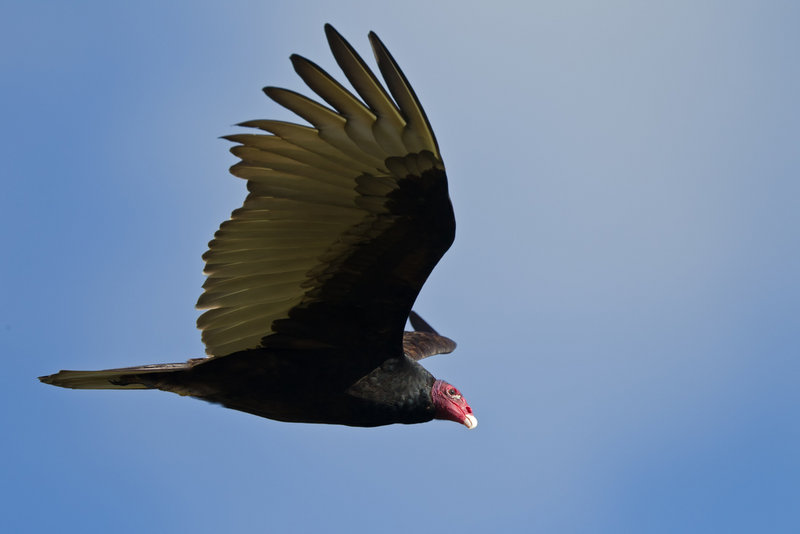A half-century ago, birders eagerly awaited the first of the spring migrants into Maine in March. The arrival of red-winged blackbirds, common grackles and American woodcock served as harbingers of spring. Now we have added turkey vulture to that list of early migrants.
Turkey vultures are easy to identify in the air, as they soar with their wings held in a shallow V. Mostly brownish, the vultures have distinctive, two-toned underwings, which are mostly white except for a black patch on the inner forward part of the wings. They often seem to rock from side to side as they soar.
Turkey vultures are common enough now in Maine during the breeding season that sightings are frequent and unremarkable. However, Ralph Palmer wrote in Maine Birds, published in 1949, that turkey vultures were rare in Maine. Palmer lists only 12 records over the period of 1862 to 1944.
A turkey vulture sighting 50 years ago would have produced great excitement among birders.
The increase in turkey vultures from a rarity to a common breeding species in Maine mirrors a more general pattern of range change. The range of the turkey vulture is huge, extending from the Prairie Provinces of Canada to the southern tip of South America. Along the California coast and much of the southeastern United States, turkey vultures are year-round residents.
During the 1960s and 1970s, North American populations of turkey vultures shifted, with western and southern populations declining as New England and Midwest populations began to increase. The over-all population has been increasing at a rate of about 1 percent per year since 1966.
Turkey vultures are scavengers. The lack of feathers on their heads is surely an adaptation to maintain cleanliness. Sticking a feathered head in a rotting carcass would certainly foul the feathers.
Turkey vultures therefore play a role in removing and recycling dead animals. They will only rarely kill their own vertebrate prey. Even then, the prey has to be defenseless.
The black vulture, a related species rarely found as found north as Maine, regularly kills defenseless prey, like newborn mammals or birds.
Even though turkey vultures pose no threat to newborn livestock (like black vultures do), they have been persecuted by farmers. Some farmers destroy turkey vultures because of a supposed role in spreading hog cholera bacteria and other livestock diseases.
The scientific support for the spread of diseases by turkey vultures is very weak. In short, we should let turkey vultures be.
How do turkey vultures find carrion? Unlike old world vultures and the black vulture, which rely on sight to find a carcass, turkey vultures rely first and foremost on their sense of smell. Turkey vultures are aerial bloodhounds! The ability to track food by smell means they can find food in densely forested areas where the canopy prevents visual recognition of prey.
Turkey vultures do have good vision as well, which certainly can be used to find carrion in open areas.
The diet of turkey vultures is broad. Mammal carrion is the most common food, ranging from mice and shrews to deer and moose. Carrion of livestock is used widely in agricultural areas. For instance, turkey vultures in southern Pennsylvania eat mostly dead domestic stock (68 percent of their diet), including dead pigs and piglets, calves, sheep and kitchen scraps.
Other food taken includes dead alligators, turtles, snakes, tadpoles, frogs and even some invertebrates (crickets, shrimp, stranded mussels).
Turkey vulture wings are well adapted for thermal soaring. The wings are broad and the primary feathers, the large feathers at the tip of the wing, are slotted to allow rising air to pass over them to generate lift.
The thermals that turkey vultures use are usually caused by uneven heating of the land. The air above a landscape feature that heats up rapidly expands and rises, to be replaced by air from surrounding cooler areas.
In turn, this cool air is heated and then rises as well. This situation results in a sustained vertical wind as long as the sun is high in the sky. Mountains or large buildings can generate updrafts as well.
You will usually not see a turkey vulture in flight before mid-morning. It takes a while for the sun to generate enough heat to cause thermals to form.
Turkey vultures generally do not ascend to great heights in a wintering or breeding area. It’s harder to pick up the smell of carrion from great heights.
During migrations, turkey vultures depend on thermals and migrate by gliding rather than flapping. Some vultures have been reported at heights of greater than 3 miles.
Herb Wilson teaches ornithology and other biology courses at Colby College. He welcomes reader comments and questions at:
whwilson@colby.edu
Send questions/comments to the editors.



Success. Please wait for the page to reload. If the page does not reload within 5 seconds, please refresh the page.
Enter your email and password to access comments.
Hi, to comment on stories you must . This profile is in addition to your subscription and website login.
Already have a commenting profile? .
Invalid username/password.
Please check your email to confirm and complete your registration.
Only subscribers are eligible to post comments. Please subscribe or login first for digital access. Here’s why.
Use the form below to reset your password. When you've submitted your account email, we will send an email with a reset code.